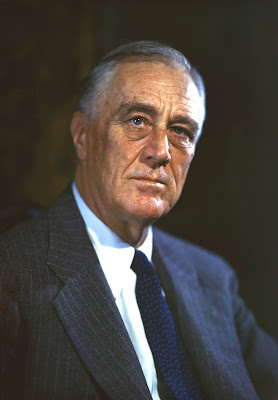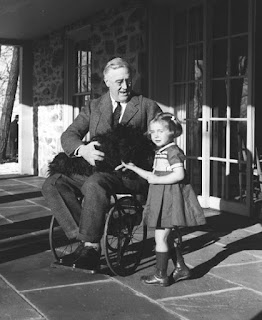 |
Franklin Delano Roosevelt (1882-1945) was the 32nd President of the United States. He was in office for four terms and led the U.S. through The Great Depression and World War II. However, it is less well known that he was a wheelchair user.
Disability and Rehab
While vacationing at his family cottage in New Brunswick, Canada, in 1921, FDR fell off his yacht. For a few days after this the power in his legs deteriorated. It reached the point where they could no longer bare his weight. He was initially mis-diagnosed as having a blood clot in his lower back. However, a few days later he was told he had infantile paralysis/ poliomyelitis, better known as polio. FDR’s initial response was (and I’m paraphrasing here) “INFANTile paralysis!! But I’m a 39 year old man!’. However, when the doctor informed him that having a weak immune system made him susceptible, he accepted the diagnosis. The polio left FDR paralysed from the waist down.
FDR was an incredibly determined man. He set his mind on making a full recovery from his ailments and neglected politics for a few years. He exercised constantly and maintained a good spirit. He tried various methods to improve his condition, of which swimming and hydrotherapy were the most effective.
 |
| Rare Photo of Roosevelt in a wheelchair |
The Cover Up?
Looking back on it now, I’m sure you must be thinking that there is no way Americans of the 1930s were open-minded enough to elect a disabled person to the highest office in the land. Well…. apparently, they were. There has been a long running tale that FDR managed to keep his disability hidden from the public from 1921 until his death in 1945. Admittedly, he made arrangements with the media, prohibiting them from photographing him in his wheelchair, or being maneuvered in a way that made his impairments obvious. I mean, the paparazzi would never invade someone’s privacy to get a story, right? Anyway, his disability was public knowledge before his election to president even occurred. In July 1931, almost two years before FDR took office, Liberty magazine with a circulation of 2.5 million, ran the article “Is Franklin D. Roosevelt Physically Fit to Be President?”. It stated,
“It is an amazing possibility that the next President of the United States may be a cripple. Franklin D. Roosevelt, Governor of the State of New York, was crippled by infantile paralysis in the epidemic of 1921 and still walks with the help of a crutch and a walking stick. Yet, by all the political signs he will emerge as the Democratic nominee.”
The fact that he ‘still walks with the help of a crutch and a walking stick’ indicated to the American people that he had recovered to a certain extent and perhaps further improvement was possible. The same article shows FDR standing barelegged wearing the metal braces which held him in an upright position. He used these braces when standing at podiums delivering speeches. He had his son and his aides essentially carry him from place to place in a way that made it seem as though he was walking. FDR tried to conceal it, but it was a known fact that he had problems.
His Charitable Work
Not too long after he was afflicted with polio, FDR was told by his friend, George Foster Peabody, that a young man, Louis Joseph, had been cured of polio, by the “healing waters” of Warm Springs in Georgia. Therefore, in 1924, FDR headed to Warm Springs in the hope of improving his condition, as the water was pure and rich in minerals. He continued to visit throughout his life causing the resort to grow in popularity. However, in 1926 Warm Springs came into financial difficulty and was on the verge of closure. Therefore, FDR invested a vast amount of his wealth into buying the resort and turning it into a rehabilitation centre for people with polio. The purchase of the resort alone before renovation cost $200,000.
Warm Springs was different from a hospital, or anywhere else where polio patients were treated. The centre was owned and managed by the people with polio who attended it. They hired the doctors and therapists and gave instructions as to what was required of them. The attendees also designed and developed their own appliances and equipment. Furthermore, Roosevelt personally developed a program of water therapy, functional training, and practical exercises. As well as this, he invented exercises, muscle charts, and equipment, while also designing wheelchairs. What’s more, he oversaw centre activities, any construction, and even paid the bills for the first two years!!
FDR began to raise money for Warm Springs with the first of his annual Birthday Balls in 1934. He encouraged people to make donations to help the centre and in the first year raised 1 million dollars. In 1938 the money also went to FDR’s new founded National Foundation for Infantile Paralysis, which is now known as March of Dimes. The continued Birthday Balls went on to fund the Salk vaccine for polio.
It is clear that Franklin D. Roosevelt did not let his disability prevent him from being a good president and making positive change in the world.
If you are interested, there is a documentary on this topic called "Franklin D. Roosevelt - The Wheelchair President".
To keep up to date with my latest blog posts, you can like my Facebook page, or follow me on Twitter. You can find them by clicking the relevant icons in the sidebar.
You may have noticed that so far, all my historical figures posts have been about powerful men, who led empires or countries. Have no fear! Next week I will be looking into…. a British politician. Slight improvement.
The Wheelchair Historian
Further Reading
Berish, Amy, ‘FDR and Polio’, Franklin D. Roosevelt Presidential Library and Museum https://www.fdrlibrary.org/polio Accessed: 4 September 2020.
Clausen, Christopher. “The President and the Wheelchair.” The Wilson Quarterly (1976-), vol. 29, no. 3, 2005, pp. 24–29. JSTOR, www.jstor.org/stable/40233058. Accessed 19 Aug. 2020.
Gallagher, Hugh, ‘FDR's Cover-Up: The Extent of His Handicap’, January 24, 1982 https://www.washingtonpost.com/archive/opinions/1982/01/24/fdrs-cover-up-the-extent-of-his-handicap/9e3f26df-c0a4-4cb6-9852-754fd54d3cae/?utm_term=.ab6c1b2c3a9c Accessed: 4 September 2020.
Ott, Tim, 'How Franklin Roosevelt’s Health Affected His Presidency’, Jan 8, 2019 https://www.biography.com/news/franklin-roosevelt-health Accessed: 4 September 2020.
Porter, Tom, ‘How FDR kept his partial paralysis a secret from the American public — even while he was on the campaign trail’ May 10, 2019, 4:10 PM https://www.businessinsider.com/how-fdr-hid-his-paralysis-from-american-public-even-while-campaigning-2019-4?r=US&IR=T Accessed: 4 September 2020.
Pressman, Matthew, ‘The Myth of FDR’s Secret Disability’, July 12, 2013 https://ideas.time.com/2013/07/12/the-myth-of-fdrs-secret-disability/ Accessed: 4 September 2020.
No comments:
Post a Comment